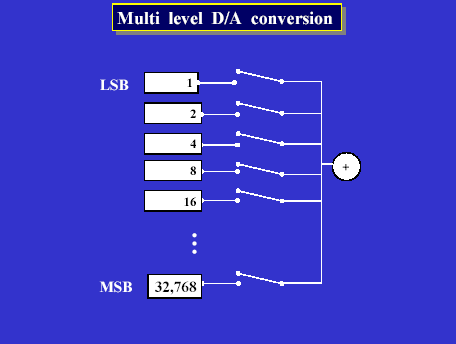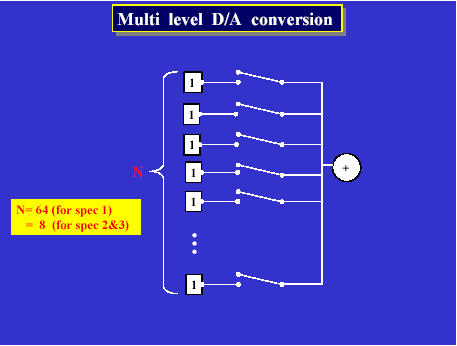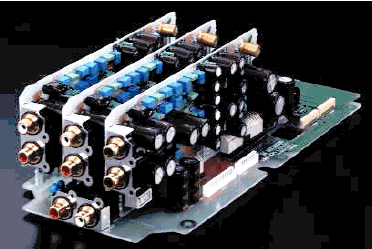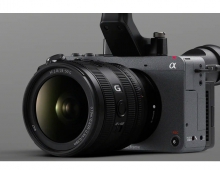Sony SCD-XA9000ES
5. Super Audio D/A Converter (SA DAC)
Review Pages
Sony SCD-XA9000ES SACD Player - Page 5
Super Audio D/A Converter (SA DAC)
Some fortunate owners will use the SCD-XA9000ES connected via the i.LINK digital interface to the Sony STR-DA9000ES, in which case the player's internal D/A converters will go unused. However, in the absence of an amplifier or receiver equipped with an i.LINK interface, owners will be using the analog outputs of the SCD-XA9000ES, in which case the player's on-board D/A converters will exert a pivotal influence on sound quality.
Multi channel Super Audio CDs present the player with six separate channels, all recorded with exactly the same superb quality as two-channel Super Audio CD. That's why the SCD-XA9000ES incorporates six channels of Sony's Super Audio D/A Converter (SA DAC). The circuit delivers superlative performance for multi-channel SA-CD, two-channel SA-CD and CD reproduction.

Sony's Super Audio D/A Converter (SA DAC) does an equally superb
job on Compact Disc signals (top) and SA-CD signals (bottom).
The converter consists of a single integrated circuit that contains four significant circuits:
- 8x oversampling digital filter for CD. Ensures accurate phase linearity and low noise.
- Noise shaper for CD to further suppress audible noise. The noise shaper also puts out a 1-bit signal at 64 times the CD sampling frequency (1-bit/64 fs). Sixty-four times 44.1 kHz equals 2.8224 MHz, the same sampling frequency as Super Audio CD. In this way, the SA DAC presents both CD and SA-CD signals to the final converter stage in the identical 1-bit/64 fs form.
- DSD filter for SA-CD, a digital filter that removes unwanted super high frequency noise by computing raw 1-bit digital data. By reducing noise in the digital domain, the DSD filter reduces the burden on analog filters and contributes to the uniformity among channels.
- Multi-level DAC for both SA-CD and CD is a breakthrough design that combines the best attributes of 1-bit converters and multi-bit converters for sound that is exceptionally transparent, against a background that is phenomenally free from noise.
Sony's multi-level digital-to-analog conversion is a significant step forward in audio technology. To appreciate the advance, it's important to understand three types of digital-to-analog converters: multi-bit, 1-bit and multi-level.

Multi-bit D/A conversion in a typical early CD player employed 16
switches, corresponding to the 16 bits of the CD sample. Each switch
produced a different level of current, according to the significance of the bit.
In the 1980s, the overwhelming majority of CD players used multi-bit Digital-to-Analog converters (DACs). Also called "ladder type" or "resistor ladder" converters, these designs typically used one resistor switch for each in the sample. The value of the resistor controlled the amount of current that flowed when the switch was On. Each switch produced current proportionate to the value of the corresponding bit. For example, the current for the Least Significant Bit (LSB) was 1, the next bit was 2, the next 4, the next 16 and so on up to the 16th or Most Significant Bit (MSB), which had a value of 32,768.
While these converters could offer superb dynamic range, they were susceptible to a distortion called nonlinearity. For any given output level, the combination of switches set On and Off would always be the same. In this way, if a switch's current source had an error, that error would always be reflected in the output level and the linearity would always be spoiled in exactly the same way.
This problem of errors and nonlinearity was especially important in the MSB, because the MSB is so big in comparison to the other bits (for example, 32,768 times the current of the LSB). So even slight errors in the MSB could overwhelm the value of the smaller bits, distorting the musical signal at the zero cross, where the binary digits flip from 1111111111111111 to 0000000000000000. These errors are generally masked by the music, when it is loud. But when the music is soft, this problem of "low-level nonlinearity" can impart a grit or hardness to the music that university researchers found to be audible.
For this reason, technologists developed 1-bit D/A converters that bypassed the problem completely. Significant among these 1-bit designs was Sony's own High Density Linear Converter™ circuit, which made its debut on the landmark CDP-X77ES in 1990 and has since been followed by Sony's Current Pulse 1-bit converter. Like other 1-bit converters, these Sony designs overcame the problem of zero-cross distortion, achieving superb low-level linearity for excellent sound, even during quiet passages and the reverberant tails at the end of musical notes.

The principle of 1-bit D/A conversion. In order to reproduce Super
Audio CD, Pulse Width Modulation must operate at a higher frequency
than the SA-CD sampling frequency of 64 fs (equal to 2.8224 MHz).
These 1-bit converters performed beautifully and dominated CD player design throughout the 1990s. However, in order to avoid the influence of jitter, to maintain linearity in the time axis, 1-bit converters need to be driven by a highly precise clock. And Super Audio Compact Disc makes this demand for precise timing even more stringent. Super Audio CD uses an extremely high sampling rate of 2,822,400 samples per second—2.8224 MHz. Many 1-bit converters employ Pulse Width Modulation, in which the converter modulates the output by creating longer or shorter pulses. Unfortunately, this requires a D/A converter clock frequency substantially higher than 2.8224 MHz. Because it's extremely difficult to maintain clock precision at such high frequencies, the signal is exposed to time-axis errors—jitter—which pass directly into the analog audio waveform, causing subtle distortion.
Such distortion was not acceptable for the design program of the ES Series SA-CD players. That's why Sony ES engineers endowed the SA DAC with Sony's multi-level D/A conversion. Unlike the multi-bit conversion used at the dawn of the digital age, multi-level conversion exhibits superb low-level linearity. And unlike the 1-bit conversion, multi-level conversion is remarkably free from jitter and jitter-induced distortion. You get the best of both worlds.
The multi-level D/A system has multiple switches controlling multiple current sources—in effect a number of 1-bit digital-to-analog converters operating in parallel. The analog output is created by summing all the current sources. Unlike 1-bit DACs, output is expressed not by the pulse width but the number of the current sources. This reduces the clock frequency, reducing the influence of clock jitter and reducing the radiation of noise into nearby circuits.

The SA DAC uses multi-level D/A conversion, illustrated here. Like multi-bit conversion,
the multi-level system uses many switches
operating in parallel.
Unlike multi-bit designs, the value of all switchesis identical—a binary 1.

The output of the multi level D/A converter varies from 0 to 64,
depending on the number of switches set to On for each sample.
 |
 |
Multi-bit conversion (left) versus multi-level conversion (right) |
To appreciate the difference between multi-bit and multi-level conversion,
take a look at the two of them, side-by-side, as shown in the diagram above.
For multi-bit conversion (left), each switch for has its own unique value. For
multi-level conversion (right), all switches have the same value, 1.
For multi-bit, each desired output corresponds to one and only one combination of switches. For example, there's only one way to generate an output of 3. In contrast, multi-level conversion has many ways to generate the same output value. The illustration on the right shows four different switch combinations that create an output of 2. In fact, Sony multi-level converters can use thousands of switch combinations to create a given output level. And the converters select the combinations at random, so output errors tend to cancel out. And errors never get the opportunity to cause the regular, predictable nonlinearities of multi-bit designs.
In this way, multi-level conversion achieves high precision in the amplitude direction and high accuracy in the time domain, for astonishing specifications and exceptional uniformity on all six channels. But the benefit is far more than just technical. You'll hear reproduction with of superb clarity, transparency and musicality.
- Tri Power DAC
From the early years of CD players, Sony engineers understood that D/A accuracy could be further improved by summing the outputs of two or more complementary converters. Summing two D/A converters for example, increases the output by a factor of two, while random noise from one converter partially cancels out noise from the other. Noise is increased by a factor of the square root of 2 (about 1.42). So the resulting signal-to-noise ratio is theoretically increased by 42%. (This 42% improvement translates to 3.0 dB better signal-to-noise ratio.)
Sony engineers have applied the same thinking to the SA-CD players of the ES Series. Sony's Tri Power DAC system applies six DACs per channel, increasing output by a factor of 3, while noise is increased by a factor of the square root of 3 (about 1.73). So the resulting signal-to-noise ratio is theoretically increased by 73%. (This 73% improvement equals 4.8 dB better signal-to-noise ratio.)

Principle of the Tri Power DAC system. By summing the outputs of six
DACs per channel, Sony increases the signal by a factor of 3, while
increasing noise by a factor of only the square root of 3.
Overall signal-to-noise is dramatically improved.
Sony introduced the Tri Power DAC in 2002, with the SCD-XA777ES SA-CD player. In 2003, Sony extends the concept with the SCD-XA9000ES.

The Sony SCD-XA777ES has six SA DAC chips with a total of 12 DACs
. In multi-channel operation, each channel's output is created by summing two DACs.
The SCD-XA777ES used six SA DAC chips for 12 DACs total. When playing back multi-channel SA-CDs, each channel is created by two DACs, for a theoretical 3 dB improvement in signal-to-noise ratio.

But when reproducing two-channel SA-CDs, Sony introduced a way to take advantage of the full processing power of the SCD-XA777ES. The TriPower DAC system uses six DACs per channel, for a theoretical 4.8 dB improvement in signal-to-noise ratio.
SCD-XA9000ES Tri Power DAC system (multi-channel playback)

The SCD-XA9000ES incorporates an incredible 18 SA DACs, which means
it delivers the precision of the Tri Power DAC system at all times,
even during multi-channel playback. Click the photo above to enlarge.
For 2003, the SCD-XA9000ES elevates the bar with Sony's most powerful conversion yet. Eighteen separate SA DAC chips deliver the precision of 36 DACs. So the SCD-XA9000ES can bring home the exalted precision of Tri Power DAC operation, even during multi-channel SA-CD playback. You get minimum noise, for maximum musical enjoyment.
- Audio Circuit Boards
The SA DACs and other parts that are crucial to the sound quality of the SCD-XA9000ES are contained on the audio circuit boards. For this reason, Sony engineers took extra care in every aspect of these circuit boards, from the choice of materials, to the circuit topology to the selection of individual component parts.


The boards themselves are environmentally-friendly using halogen-free glass epoxy material. Careful design of board topology simplifies the signal path. And Sony has made extensive use of surface-mount parts and leadless resistors, which cut signal travel to the bare minimum. In this way, the sound is protected from radiated interference and the uniformity of all six output channels is improved.
The power supply can become a path for noise to leak from the digital system board to the audio boards. For this reason, Sony took the extra step of building a dedicated power supply just for audio. This minimizes even subtle noise and interference.
Review Pages





















